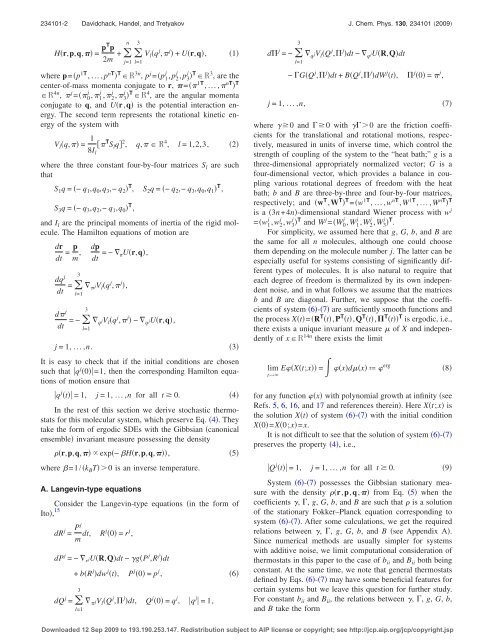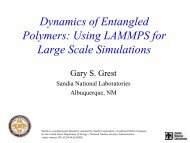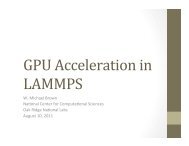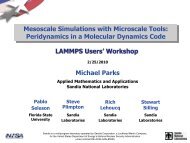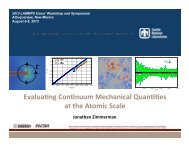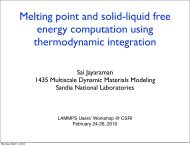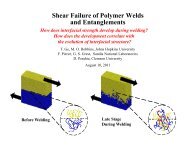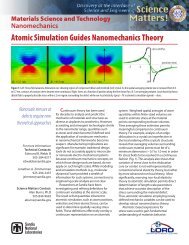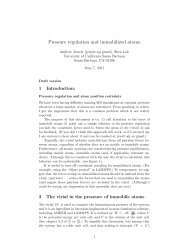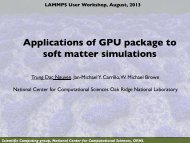Langevin thermostat for rigid body dynamics - Lammps
Langevin thermostat for rigid body dynamics - Lammps
Langevin thermostat for rigid body dynamics - Lammps
Create successful ePaper yourself
Turn your PDF publications into a flip-book with our unique Google optimized e-Paper software.
234101-2 Davidchack, Handel, and Tretyakov J. Chem. Phys. 130, 234101 2009<br />
Hr,p,q, = pT p<br />
2m + <br />
n<br />
<br />
l=1<br />
j=1<br />
3<br />
V l q j , j + Ur,q,<br />
where p=p 1T ,...,p nT T R 3n , p j =p j 1 , p j 2 , p j 3 T R 3 , are the<br />
center-of-mass momenta conjugate to r, = 1T ,..., nT T<br />
R 4n , j = j 0 , j 1 , j 2 , j 3 T R 4 , are the angular momenta<br />
conjugate to q, and Ur,q is the potential interaction energy.<br />
The second term represents the rotational kinetic energy<br />
of the system with<br />
V l q, = 1 T S l q 2 , q, R 4 , l = 1,2,3, 2<br />
8I l<br />
where the three constant four-by-four matrices S l are such<br />
that<br />
S 1 q = − q 1 ,q 0 ,q 3 ,− q 2 T , S 2 q = − q 2 ,− q 3 ,q 0 ,q 1 T ,<br />
S 3 q = − q 3 ,q 2 ,− q 1 ,q 0 T ,<br />
and I l are the principal moments of inertia of the <strong>rigid</strong> molecule.<br />
The Hamilton equations of motion are<br />
dr<br />
dt = p m ,<br />
3<br />
dp<br />
dt =− rUr,q,<br />
dq j<br />
dt = jV l q j , j ,<br />
l=1<br />
d j<br />
dt<br />
3<br />
=− q jV l q j , j − q jUr,q,<br />
l=1<br />
j =1, ...,n.<br />
It is easy to check that if the initial conditions are chosen<br />
such that q j 0=1, then the corresponding Hamilton equations<br />
of motion ensure that<br />
q j t =1, j =1, ...,n <strong>for</strong> all t 0. 4<br />
In the rest of this section we derive stochastic <strong>thermostat</strong>s<br />
<strong>for</strong> this molecular system, which preserve Eq. 4. They<br />
take the <strong>for</strong>m of ergodic SDEs with the Gibbsian canonical<br />
ensemble invariant measure possessing the density<br />
r,p,q, exp− Hr,p,q,,<br />
where =1/k B T0 is an inverse temperature.<br />
A. <strong>Langevin</strong>-type equations<br />
Consider the <strong>Langevin</strong>-type equations in the <strong>for</strong>m of<br />
Ito, 15<br />
dR j = Pj<br />
m dt, Rj 0 = r j ,<br />
dP j =− r jUR,Qdt − gP j ,R j dt<br />
1<br />
3<br />
5<br />
+ bR j dw j t, P j 0 = p j , 6<br />
3<br />
dQ j = jV l Q j , j dt, Q j 0 = q j , q j =1,<br />
l=1<br />
3<br />
d j =− q jV l Q j , j dt − q jUR,Qdt<br />
l=1<br />
− GQ j , j dt + BQ j , j dW j t, j 0 = j ,<br />
j =1, ...,n,<br />
where 0 and 0 with 0 are the friction coefficients<br />
<strong>for</strong> the translational and rotational motions, respectively,<br />
measured in units of inverse time, which control the<br />
strength of coupling of the system to the “heat bath;” g is a<br />
three-dimensional appropriately normalized vector; G is a<br />
four-dimensional vector, which provides a balance in coupling<br />
various rotational degrees of freedom with the heat<br />
bath; b and B are three-by-three and four-by-four matrices,<br />
respectively; and w T ,W T T =w 1T ,...,w nT ,W 1T ,...,W nT T<br />
is a 3n+4n-dimensional standard Wiener process with w j<br />
=w 1 j ,w 2 j ,w 3 j T and W j =W 0 j ,W 1 j ,W 2 j ,W 3 j T .<br />
For simplicity, we assumed here that g, G, b, and B are<br />
the same <strong>for</strong> all n molecules, although one could choose<br />
them depending on the molecule number j. The latter can be<br />
especially useful <strong>for</strong> systems consisting of significantly different<br />
types of molecules. It is also natural to require that<br />
each degree of freedom is thermalized by its own independent<br />
noise, and in what follows we assume that the matrices<br />
b and B are diagonal. Further, we suppose that the coefficients<br />
of system 6-7 are sufficiently smooth functions and<br />
the process Xt=R T t,P T t,Q T t, T t T is ergodic, i.e.,<br />
there exists a unique invariant measure of X and independently<br />
of xR 14n there exists the limit<br />
lim EXt;x = xdx ª erg<br />
t→<br />
<strong>for</strong> any function x with polynomial growth at infinity see<br />
Refs. 5, 6, 16, and 17 and references therein. Here Xt;x is<br />
the solution Xt of system 6-7 with the initial condition<br />
X0=X0;x=x.<br />
It is not difficult to see that the solution of system 6-7<br />
preserves the property 4, i.e.,<br />
7<br />
8<br />
Q j t =1, j =1, ...,n <strong>for</strong> all t 0. 9<br />
System 6-7 possesses the Gibbsian stationary measure<br />
with the density r,p,q, from Eq. 5 when the<br />
coefficients , , g, G, b, and B are such that is a solution<br />
of the stationary Fokker–Planck equation corresponding to<br />
system 6-7. After some calculations, we get the required<br />
relations between , , g, G, b, and B see Appendix A.<br />
Since numerical methods are usually simpler <strong>for</strong> systems<br />
with additive noise, we limit computational consideration of<br />
<strong>thermostat</strong>s in this paper to the case of b ii and B ii both being<br />
constant. At the same time, we note that general <strong>thermostat</strong>s<br />
defined by Eqs. 6-7 may have some beneficial features <strong>for</strong><br />
certain systems but we leave this question <strong>for</strong> further study.<br />
For constant b ii and B ii , the relations between , , g, G, b,<br />
and B take the <strong>for</strong>m<br />
Downloaded 12 Sep 2009 to 193.190.253.147. Redistribution subject to AIP license or copyright; see http://jcp.aip.org/jcp/copyright.jsp


